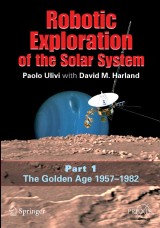Details

Robotic Exploration of the Solar System
Part I: The Golden Age 1957-1982Springer Praxis Books
|
58,84 € |
|
| Verlag: | Praxis |
| Format: | |
| Veröffentl.: | 08.12.2007 |
| ISBN/EAN: | 9780387739830 |
| Sprache: | englisch |
| Anzahl Seiten: | 536 |
Dieses eBook enthält ein Wasserzeichen.
Beschreibungen
<P>Paolo Ulivi and David Harland provide in Robotic Exploration of the Solar System a detailed history of unmanned missions of exploration of our Solar System. As in their previous book Lunar Exploration, the subject will be treated wherever possible from an engineering and scientific standpoint. Technical descriptions of the spacecraft, of their mission designs and of instrumentations will be provided. Scientific results will be discussed in considerable depth, together with details of mission management. The book will be comprehensive, covering missions and results from the 1950s until the present day, and some of the latest missions and their results will appear in a popular science book for the first time. The authors will also cover many unflown missions, providing an indication of the ideas that proved to be unfulfilled at the time but which may still be proven and useful in the future. The project will deliver three volumes totaling over 1000 pages, providing comprehensive coverage of the topic.</P>
Introduction.- The beginning.- Of landers and orbiters.- The grandest tour.- Acronyms.- Glossary.- Appendices.- Chapter references.- Further reading.- Index.
<P>The Second World War left among its many and painful heritages a new technology, ballistic missiles, that was to change the world, providing a way to carry into space instruments, satellites and probes that revolutionized science and technology.</P>
<P></P>
<P>Prior to launching artificial satellites, both the then Soviet Union and the United States developed more powerful intercontinental missiles with a range of thousands of miles. In the 1950s, the Soviets designed the huge 8K71 "Semiorka" (little seven, after the military designator R 7), a single staged rocket equipped with four large boosters and able to carry an heavy thermonuclear warhead to the continental US. In the USA, competition between the different armed forces prevailed, and the Army developed the medium range Redstone and Jupiter missiles, whilst the Air Force developed the Thor and two different ICBMs, Atlas and Titan and the Navy developed the Polaris submarine launched missiles.</P>
<P></P>
<P>The potential of all of these rockets to boost spacecraft were huge, but while in the Soviet Union it was decided to modify an 8K71 to carry a scientific payload into space, the United States decided that the Navy would develop a tiny new rocket called Vanguard, specifically designed for the task. This decision was to have grave repercussions: on 4 October 1957 the Soviet Union launched its PS-1 satellite, better known as Sputnik, which rocked the USA. This was compounded a month later by the launch of the PS-2, carrying the dog Laika. Following the explosion of the first Vanguard on December 6, the US Army then had the task to restore the American confidence by successfully carrying Explorer 1 into space on 1 February 1958 using the modified Redstone rocket called Juno 1. During the same year, the superpowers started working on new versions of their missiles able to carry small payloads to the Moon and, potentially, to the near planets. The space race had begun.</P>
<P></P>
<P>Prior to launching artificial satellites, both the then Soviet Union and the United States developed more powerful intercontinental missiles with a range of thousands of miles. In the 1950s, the Soviets designed the huge 8K71 "Semiorka" (little seven, after the military designator R 7), a single staged rocket equipped with four large boosters and able to carry an heavy thermonuclear warhead to the continental US. In the USA, competition between the different armed forces prevailed, and the Army developed the medium range Redstone and Jupiter missiles, whilst the Air Force developed the Thor and two different ICBMs, Atlas and Titan and the Navy developed the Polaris submarine launched missiles.</P>
<P></P>
<P>The potential of all of these rockets to boost spacecraft were huge, but while in the Soviet Union it was decided to modify an 8K71 to carry a scientific payload into space, the United States decided that the Navy would develop a tiny new rocket called Vanguard, specifically designed for the task. This decision was to have grave repercussions: on 4 October 1957 the Soviet Union launched its PS-1 satellite, better known as Sputnik, which rocked the USA. This was compounded a month later by the launch of the PS-2, carrying the dog Laika. Following the explosion of the first Vanguard on December 6, the US Army then had the task to restore the American confidence by successfully carrying Explorer 1 into space on 1 February 1958 using the modified Redstone rocket called Juno 1. During the same year, the superpowers started working on new versions of their missiles able to carry small payloads to the Moon and, potentially, to the near planets. The space race had begun.</P>
The 3-volume series will provide comprehensive coverage with thousands of references to the professional literature that should make it the 'first port of call' for people seeking information on the topic Emphasises the technology of space probes Comprehensive coverage ranges from the earliest planetary probes to the most recent planetary flights and missions Provides multilingual references (including Chinese, Russian, Czech, French, Italian) Details many unflown and unfulfilled missions, which may still be proven and useful in the future Describes the technical rivalry between the US and Soviet Union in the development of launchers
<P>Provides a comprehensive review of the exploration of the Solar System</P>
<P>Focusing on the technology of the robotic space probes that made it possible</P>
<P>Including missions which – for a variety of reasons – were never completed</P>
<P>Focusing on the technology of the robotic space probes that made it possible</P>
<P>Including missions which – for a variety of reasons – were never completed</P>

















